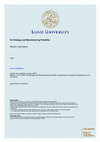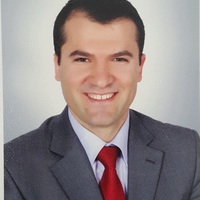Papers by Carl-Henric Nilsson

plastic crate. This paper describes how the five Swedish corrugated box manufacturers, while stil... more plastic crate. This paper describes how the five Swedish corrugated box manufacturers, while still in fierce competition, got together in 1999 to fight a new logistic system, plastic crates, which threatened to overtake a substantial part of the Swedish market for transport packaging. It explains the background of SWIF 2000, the competitive response by the five Swedish corrugated box manufacturers, how the strategy was developed, and what made the competitors work together. Many driving forces influence competition. A common tool for structuring competitive forces is Porter’s (1980) five-forces which in this paper is applied to the corrugated industry. Although Porter’s analysis of competition is a good starting point for analysing the problems for the corrugated industry in Sweden, other tools and models are needed to fully comprehend the situation. Theories from two areas are used to understand the case: 1) Strategic Alliances, 2) Hypercompetition.

Can an educational programme develop tomorrow’s leaders? Can the mindset and skill set found in s... more Can an educational programme develop tomorrow’s leaders? Can the mindset and skill set found in successful leaders be taught and learnt in educational programmes? This paper presents a leadership program, a cross disciplinary master programme atLund University, Sweden. The students study technology and management, however, the programme’s unique value proposition lies in its focus on leadership.The leadership part of the programme is based on three core buildingblocksthat are intimately intertwined and forms an holistic platform for the programme:1. The understanding of fixed and growth mindset (Dweck, 2006)2. The process of becoming and belonging (Wenger, 2000a)3. The individual learning journal tool (Moon, 20006).We (the teachers involved in the programme) are convinced that the development that the students go through during the programme is a consequence of its pedagogical approach that puts the student in the front seat. A student from the programme expresses it in the followin...
A managerial view, Lund Institute …, 2004
In this paper we are investigating how project complexity is affecting the management of single p... more In this paper we are investigating how project complexity is affecting the management of single projects in a multi-project environment. The project manager's perspective is applied. A conceptual framework is developed in order to summarize how project complexity effect project ...

Idag utvecklas inom olika omraden nya tankesatt och handlingsmonster som bygger pa helhet, integr... more Idag utvecklas inom olika omraden nya tankesatt och handlingsmonster som bygger pa helhet, integration och fokusering av floden. I framtiden kommer konkurrensen att ske mellan olika kedjor av foretag, inte mellan enskilda foretag. Traditionella organisationsgranser och mal ar i dessa nya sammanhang av underordnad betydelse. De nya tankesatten gor foradlings-/forsorjningskedjan mer effektiv. De innebar att nya affarsideer och foretag utvecklas – som elektronisk handel och tredjepartslogistik – dar otraditionella losningar for floden ofta utgor en viktig del. Dessa nya tankar och handlingsmonster haller pa att forandra vara foradlings-/forsorjningskedjor i grunden, och mycket av det som vi idag anser vara helt nodvandigt och sjalvklart kommer snart att vara ett minne blott. Boken ger en allman introduktion till omradet flodesekonomi (supply chain management) och riktar sig till studenter pa hogskolor och universitet samt till foretagsinterna utbildningar. Den ar aven vardefull for alla andra som i sitt arbete behover satta sig in i eller uppdatera sina kunskaper inom omradet.

LUTMDN/TMIO--1004--SE; (1995), 1995
have felt that I have walked alone several times during the course of this thesis (especially in ... more have felt that I have walked alone several times during the course of this thesis (especially in the small hours of the morning at the Department), my friends at the Department have not been many hours away. To all of you, thank you for your encouragement and good spirits during these years, I will bear this with me in the future. Much of the research has been carried out in different constellations. Although I take responsibility for what is written in this thesis, I can not possibly take all the credit for it. First of all, I would like to direct my thanks to my tutor Ingvar Persson, who has put up with me for such an extended period of time. Truly a remarkable task. He has furthermore guided me with a firm hand towards asking the right questions and viewing problems from several different perspectives. He also managed to bring home to me the significance of methodology for scientists. Ingvar provided the base from which I have probed my areas of research. Next, my thoughts go to Håkan Nordahl. We worked together throughout the Master's programme, and later on to our Licentiate degree. I have done most of my work on flexibility with Håkan, whom I admire for his stringency as a scientist and dependability as a good friend. Who else would come to the Department at 2 am, on December 30, to give his comments, valuable as always, on the frame of reference for this thesis? After my Licentiate degree, I continued with teamwork , a form that I find rewarding from several aspects. I believe the results of the research to be improved and it is, not least, much more fun than going it alone. Jörgen Dernroth, a true artist, and myself joined efforts in the study of the competitive advantage of Scania heavy trucks. I consider myself privileged to have been working together with such skilful people during my doctoral studies. Towards the end of my studies, my second tutor, Rikard Larsson, joined the team agreeing to bring the boat into port. A better helmsman for that duty could not have been found, of that I am sure. With unprecedented decisiveness he has pushed me beyond previously conceived mental limits, and I hardly dare to speculate what would have happened (or not) with this thesis, had Rikard not been engaged. I would certainly have missed a very accomplished scientist and a sincere friend. Now, my thoughts go to my family; to my parents, June and Allan and my sister Anneli, for their continuous support and for inculcating upon me the importance of eating and sleeping as a complement to working, to Calle and Katla, who rightly asked me why I did not get myself another job, so that I did not have to work all the time, and finally, and most importantly, my thoughts go to, and stay with, my wife and research colleague, Guggy. You have had to put up with my mental and physical absence, around the clock, for much too long. The most remarkable thing to me is that you still miss me when I am not at home. My absence and your unintentional loneliness is now, at last, over.
The literature on strategic alliances is vast. Most authors are pro-alliances and the casual read... more The literature on strategic alliances is vast. Most authors are pro-alliances and the casual reader may thereby be lulled into a false sense of security concerning the advantages of strategic alliances. There are several possible advantages of strategic alliances however by joining an alliance several opportunities are also forsaken. The opposite strategic option, a "go it alone strategy" generates several strategic advantages which would be difficult to gain in a strategic alliance. The literature on strategic alliances is reviewed concerning the motives for forming alliances and the way in which examples of alliances are used, and misused, in the literature by scholars. The case of Scania, the Swedish heavy truck producer, is then presented as an example of the strategic advantages that can be achieved by not entering into horizontal strategic alliances.











Uploads
Papers by Carl-Henric Nilsson